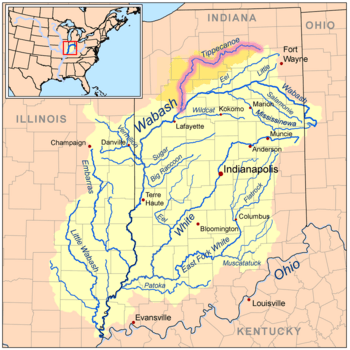Tippecanoe River facts for kids
Quick facts for kids Tippecanoe River |
|
|---|---|

Map of the Wabash River watershed with the Tippecanoe River highlighted.
|
|
| Country | US |
| Physical characteristics | |
| Main source | Big Lake in Noble County, Indiana |
| River mouth | Wabash River near Battle Ground, Indiana |
| Length | 182 miles (293 km) |
| Basin features | |
| Basin size | 1,875 sq mi (4,860 km2) |
The Tippecanoe River (pronounced TIP-ee-kə-NOO) is a calm, 182-mile-long river in northern Indiana. It starts at Big Lake in Noble County. The river then flows to the Wabash River near Battle Ground. This spot is about 12 miles northeast of Lafayette. The name "Tippecanoe" comes from a word in the Miami-Illinois language. It means "buffalo fish."
The Tippecanoe River gets its water from 88 natural lakes. Its watershed covers a huge area of 1,250,000 acres across 14 counties. This river is home to many rare and endangered animals and plants. It has more different kinds of species than most rivers in the upper Midwest. The Nature Conservancy has even called it one of the top ten rivers in the United States to protect. This is because of its amazing variety of life.
The River's Journey
The Tippecanoe River begins in Noble County, Indiana. It starts from many small lakes. These lakes were formed by ancient glaciers, which were huge sheets of ice. People built several dams along the river. These dams created lakes and ponds. They were used to power mills and other things long ago.
The river flows west into Wilmot Pond. After Wilmot, it enters Kosciusko County. There, it flows into Backwaters Lake, which is part of Webster Lake. After going over the dam at Webster Lake, the river travels a few miles. It then enters Tippecanoe Lake.
From Tippecanoe Lake, the river flows south and west. It goes through the southeast part of Marshall County. Then it bends northwest through Fulton County and Pulaski County. It even flows through Tippecanoe River State Park.
Next, the river enters White County. Here, dams create two large lakes: Lake Freeman and Lake Shafer. The river leaves Lake Freeman from the south. It then flows through the western part of Carroll County. Finally, it reaches Tippecanoe County. This is where it joins the larger Wabash River.
Five areas, called townships, are also named Tippecanoe. They are located along the river's path:
- Tippecanoe Township, Carroll County, Indiana
- Tippecanoe Township, Kosciusko County, Indiana
- Tippecanoe Township, Marshall County, Indiana
- Tippecanoe Township, Pulaski County, Indiana
- Tippecanoe Township, Tippecanoe County, Indiana
Historical Events
A very important event happened near the south bank of the river. This was the Battle of Tippecanoe. In this battle, William Henry Harrison defeated a group of Native American tribes. Harrison later became a President of the United States. The city of Lafayette grew up near this historic site.
River Dams
In the 1920s, two dams were built on the Tippecanoe River. Their purpose was to create electricity.
- The Oakdale Hydro Plant was built in 1925. It created Lake Freeman. This lake stretches about 7 miles north through Monticello. It produces 9.2 megawatts of power.
- The Norway Hydro Plant was also built in 1925. It created Lake Shafer. This lake extends about 6 miles north from Norway. It produces 7.2 megawatts of power.

